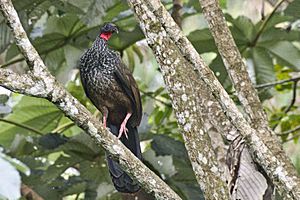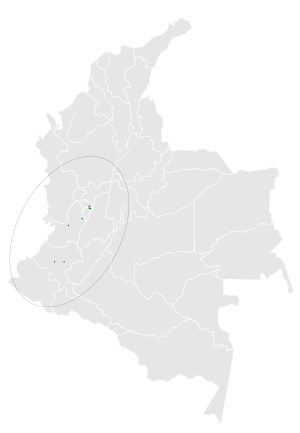Cauca guan facts for kids
Quick facts for kids Cauca guan |
|
|---|---|
 |
|
| Conservation status | |
| Scientific classification | |
| Genus: |
Penelope
|
| Species: |
perspicax
|
 |
|
The Cauca guan (Penelope perspicax) is a special type of bird. It belongs to a family of birds called Cracidae, which includes chachalacas, guans, and curassows. This large bird mostly lives in trees in humid forests. It loves to eat fruits and leaves.
The Cauca guan is found only in Colombia. Specifically, it lives in the Cauca River valley. In Spanish, people call this bird pava caucana.
Contents
About the Cauca Guan
What's in a Name?
The Cauca guan was first officially described in 1911. An American bird expert named Outram Bangs gave it its scientific name.
The name Penelope comes from an old Greek word. It was for a type of duck. The second part of its name, perspicax, is Latin. It means "sharp-sighted." This bird is the only species of its kind, meaning there are no different types (subspecies) of Cauca guan.
What Does It Look Like?
These are big birds, usually about 75 to 85 centimeters (about 2.5 to 2.8 feet) long. They have a plump body, a long tail, and a small head.
Their head, neck, and upper back are dark grey. This color blends into a reddish-brown on their lower back, wings, and upper tail. Their main flight feathers are greyish-brown. The underside of their tail feathers is grey.
The feathers on their back, throat, chest, and belly have white outlines. This makes them look like they have scales. A bright red patch of skin hangs from their throat. This is called a gular sac. Their legs and feet are red, and so are their eyes. Their beak is dark grey.
Where Does It Live?
The Cauca guan is found only in Colombia. Long ago, it lived in a large area of the Cauca River valley. It was also found on the western side of the Andes mountains.
By the 1980s, people thought this bird might be gone forever. But small groups of them have been found since then. They live in parts of the Cauca, Valle del Cauca, Quindío, and Risaralda regions.
These birds live in places that are 900 to 2500 meters (about 3,000 to 8,200 feet) above sea level. They like humid forests, both old and new. They can also be found at the edges of forests and in tree farms.
How It Lives
What Does It Eat?
Cauca guans look for food in bushes and trees. They usually search between 2 and 20 meters (about 6 to 65 feet) off the ground. Most of the time, they forage alone or in small family groups of 3 or 4 birds. Sometimes, larger groups of up to 30 birds gather to eat.
They mostly eat fruit. They also eat some leaves and flowers. They are not picky eaters. One study found that they ate 89 different kinds of fruit! They eat most fruits whole. But they will bite pieces off bigger fruits, like those from fig trees.
When fruit is hard to find, they eat a lot of young leaves from Chinese ash trees. These birds also look for small insects on the ground. Groups of them have been seen following swarms of Army ants. They eat the insects that try to escape the ants.
Cauca guans sometimes eat with other bird species. They don't seem to fight with these other birds. But they will protect a good food spot from other Cauca guans.
Raising a Family
The time of year when Cauca guans breed depends on the weather and how much food is available. In one protected area, they breed from January to June. This is when there is a lot of fruit.
Not many of their nests have been found. But it seems they build them from dry leaves and twigs. They usually place their nests 1 to 2 meters (about 3 to 6 feet) above the ground in trees or bushes. One nest found was described as "not very fancy." It was built in thick ferns.
They usually lay 2 or 3 large white eggs. Each egg weighs about 94 to 96 grams. For comparison, a very large chicken egg weighs about 64 grams. Only the female bird sits on the eggs to keep them warm.
Sounds It Makes
The Cauca guan makes several different sounds. They have a squawking alarm call that they repeat quickly. They also make a long, drawn-out call that sounds like "kōō’EEl." You can often hear a loud rattling sound from their wings in the morning. This wing rattling also seems to be part of how they attract a mate.
Protecting the Cauca Guan
The Cauca guan is a vulnerable species. This means it is at risk of disappearing. It is on the IUCN Red List, which tracks endangered animals.
It used to live in a very large area. Now, it is found in only four smaller, separate places. The total number of adult birds is estimated to be between 1,000 and 2,500. Only one group has more than 250 adults.
Why It's in Danger
The biggest problem for the Cauca guan is that its home is shrinking. Forests are being cut down, and their habitat is broken into small pieces. The areas where the birds live are surrounded by deforested land. This means the populations cannot grow larger.
These small groups of birds are also at risk from hunting. Large birds are often hunted for food. The Cauca guan is big and makes a lot of noise, so it can be easy to find. In one area, up to 100 birds are killed each year. The very small groups of birds are especially in danger of being wiped out by hunting.
Helping Them Survive
The two largest groups of Cauca guans live inside protected areas. These areas are the PNR Ucumarí/SFF Otún Quimbaya and the Bosque de Yotoco Natural Reserve. The number of birds in these areas seems to be stable.
A plan to protect the birds was made in 2005. Experts are now watching the bird populations. In the Yotoco forest, university students and volunteers help monitor the birds. This is a good way to keep track of them for a long time.
The Cali Zoo also has a program to breed Cauca guans. This is helpful in case the birds need to be released back into suitable habitats in the future.
See also
 In Spanish: Pava caucana para niños
In Spanish: Pava caucana para niños


